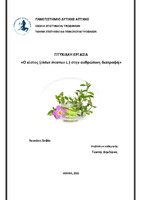| dc.contributor.advisor | Τυμπής, Δημήτριος | |
| dc.contributor.author | Λαγκάνη, Σοφία | |
| dc.date.accessioned | 2021-07-13T10:17:43Z | |
| dc.date.available | 2021-07-13T10:17:43Z | |
| dc.date.issued | 2021-07-08 | |
| dc.identifier.uri | https://polynoe.lib.uniwa.gr/xmlui/handle/11400/765 | |
| dc.identifier.uri | http://dx.doi.org/10.26265/polynoe-616 | |
| dc.description.abstract | O κίστος (Cistus incanus L.) γνωστός στην Ελλάδα και ως λάβδανο ή κουνούκλα με συνώνυμα όπως Cistus creticus ή cistus villosus ή hairy rockrose, είναι γηγενής μεσογειακός θάμνος της οικογένειας Cistaceae και ανήκει στα τραχειόφυτα σπερματόφυτα. Έχει ερμαφρόδιτα άνθη χρώματος μωβ και χνουδωτά φύλλα. Υπάρχουν ιστορικές αναφορές από τον Ιπποκράτη, τον Θεόφραστο, τον Ρωμαίο Celsus και άλλους γιατρούς της αρχαιότητας για τις θεραπευτικές και καλλυντικές ιδιότητες του Cistus incanus L. στα αρχαία χρόνια ενώ ο πρώτος λαός που προχώρησε στη συλλογή της ρητίνης του Cistus incanus L. ήταν οι Αρχαίοι Αιγύπτιοι. Λόγω του εποχιακού διμορφισμού του ο κίστος προσαρμόζεται στο μεσογειακό περιβάλλον και αναπτύσσεται σε παραθαλάσσια βραχώδη μέρη σε έως και 1000 μέτρα υψόμετρο κατά μήκος της παράκτιας ζώνης της Κεντρικής – Ανατολικής Μεσογείου. Το φυτό αυτό έχει ελάχιστες εδαφικές και θρεπτικές απαιτήσεις ενώ για να ανταπεξέλθει ικανοποιητικά χρειάζεται ηλιόλουστες θέσεις. Για την καλλιέργεια τα καλύτερα αποτελέσματα τα δίνει ο πολλαπλασιασμός με σπόρο που συλλέγεται νωρίς την άνοιξη. Η παραδοσιακή συλλογή της ρητίνης του λάδανου γίνεται τις θερμές ώρες της ημέρας του καλοκαιριού με τη χρήση του αργαστηρίου ή από το τρίχωμα των κατσικιών που βόσκουν ανάμεσα στις λαδανιές. Η παραλαβή του αιθέριου ελαίου γίνεται με απόσταξη με υδρατμούς ή εκχύλιση με διαλύτες. Ο κίστος είναι πλούσιος σε φαινολικές ενώσεις και φλαβονοειδή με αντιβακτηριδιακές, αντιφλεγμονώδεις, αντιιικές, κυτταροτοξικές και αντιμυκητιακές ιδιότητες. Σήμερα ο κίστος χρησιμοποιείται για την διατροφή του ανθρώπου σε μορφή αφεψήματος, και ως πρόσθετο σε συμπληρώματα διατροφής ενώ σε τρόφιμα έχει χρησιμοποιηθεί μόνο σε χυμό αλόης. Έρευνες έχουν δείξει ότι η χρήση του Cistus incanus L. είναι αρκετά ωφέλιμη και εφικτή σε προϊόντα αρτοποιίας, όπως το ψωμί και σε ζυμαρικά εφόσον τα οργανοληπτικά χαρακτηριστικά των προϊόντων, καθώς και η αντιοξειδωτική δράση του πρόσθετου κρίθηκαν θετικά και αποδεκτά. | el |
| dc.format.extent | 73 | el |
| dc.language.iso | el | el |
| dc.publisher | Πανεπιστήμιο Δυτικής Αττικής | el |
| dc.rights | Αναφορά Δημιουργού - Μη Εμπορική Χρήση - Παρόμοια Διανομή 4.0 Διεθνές | * |
| dc.rights | Αναφορά Δημιουργού-Μη Εμπορική Χρήση 4.0 Διεθνές | * |
| dc.rights | Αναφορά Δημιουργού-Μη Εμπορική Χρήση 4.0 Διεθνές | * |
| dc.rights.uri | http://creativecommons.org/licenses/by-nc/4.0/ | * |
| dc.subject | Cistus incanus L. | el |
| dc.subject | Κίστος | el |
| dc.subject | Λάβδανο | el |
| dc.subject | Πρόσθετο | el |
| dc.subject | Αντιοξειδωτική δράση | el |
| dc.title | Ο κίστος (Cistus incanus L.) στην ανθρώπινη διατροφή | el |
| dc.title.alternative | The effect of Cistus incanus in human nutrition | el |
| dc.type | Πτυχιακή εργασία | el |
| dc.contributor.committee | Kanellou, Anastasia | |
| dc.contributor.committee | Τριάντη, Μυρτώ | |
| dc.contributor.faculty | Σχολή Επιστημών Τροφίμων | el |
| dc.contributor.department | Τμήμα Επιστήμης και Τεχνολογίας Τροφίμων | el |
| dc.description.abstracttranslated | Cistus incanus L. known in Greece as Kistos, labdano or kounoukla with synonyms such as Cistus creticus or cistus villosus or hairy rockrose, is a native Mediterranean shrub of the Cistaceae family and belongs to the trachiophyte spermatophytes. It has purple hermaphroditic flowers and fluffy leaves. There are historical references by Hippocrates, Theophrastus, Romeo Celsius and other doctors of antiquity about the healing and cosmetic properties of Cistus incanus L. in ancient times while the first people who collected the resin of Cistus incanus L. were the Ancient Egyptians. Due to its seasonal dimorphism, Cistus incanus L. adapts to the Mediterranean environment and develops in coastal rocky places up to 1000 meters altitude along the coastal zone of the Central - Eastern Mediterranean. This plant has minimal soil and nutritional requirements and needs sunny places to cope satisfactorily. For cultivation, the best results are obtained by propagation from seed collected in early spring. The traditional collection of the resin of labdanum is done during the hot summer daylight hours using the laboratory or from the hair of the goats grazing among the fields of Cistus incanus L. The essential oil is obtained by steam distillation or solvent extraction. Cistus is rich in phenolic compounds and flavonoids with antibacterial, anti-inflammatory, antiviral, cytotoxic and antifungal properties. Today, Cistus incanus L. is used for human nutrition in the form of tea and as an additive in dietary supplements, while in food it has been used only in aloe juice. Research has shown that the use of Cistus incanus L. is potential beneficial and feasible in bakery products such as bread and pasta products while the sensory characteristics of the products, as well as the antioxidant activity of the additive were evaluated positively and acceptable. | el |


